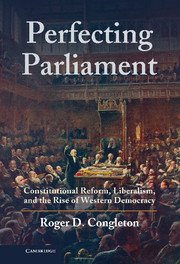Book contents
- Frontmatter
- Contents
- Preface
- 1 On the Origins of Western Democracy
- Part I Sharing Sovereignty
- Part II Historical Evidence on Western Democratic Transitions
- Part III Analytical History as Social Science
- 19 Quantitative Evidence of Gradual Reform
- 20 Ideas, Interests, and Constitutional Reform
- Appendix Methodological Approach, Limits, and Extensions
- References
- Index
20 - Ideas, Interests, and Constitutional Reform
Published online by Cambridge University Press: 05 June 2012
- Frontmatter
- Contents
- Preface
- 1 On the Origins of Western Democracy
- Part I Sharing Sovereignty
- Part II Historical Evidence on Western Democratic Transitions
- Part III Analytical History as Social Science
- 19 Quantitative Evidence of Gradual Reform
- 20 Ideas, Interests, and Constitutional Reform
- Appendix Methodological Approach, Limits, and Extensions
- References
- Index
Summary
The theory of constitutional design and reform developed in this volume explains the essential architecture of parliamentary democracy and the path of reform that produced it. It explains why policy-making authority tends to be divided, why the distribution of policy-making authority changes through time, and why this normally is done without radically changing the standing procedures for governance. It demonstrates that significant shifts of the distribution of policy-making authority within divided governments can occur peacefully and lawfully through a process analogous to exchange in markets. The analysis suggests that a series of such constitutional reforms can gradually transform a more or less authoritarian system into a parliamentary democracy.
The historical narratives of Part II suggest that liberal democracy emerged in this manner. Trends in economic and ideological interests allowed a series of liberal reforms to be negotiated and adopted by kings and parliaments during the nineteenth and early twentieth centuries. These constitutional and quasi-constitutional reforms gradually produced the rules of economic and political life that we largely take for granted in the West. Indeed, those new rules can be said to have created the West.
- Type
- Chapter
- Information
- Perfecting ParliamentConstitutional Reform, Liberalism, and the Rise of Western Democracy, pp. 591 - 610Publisher: Cambridge University PressPrint publication year: 2010



